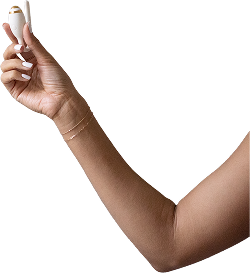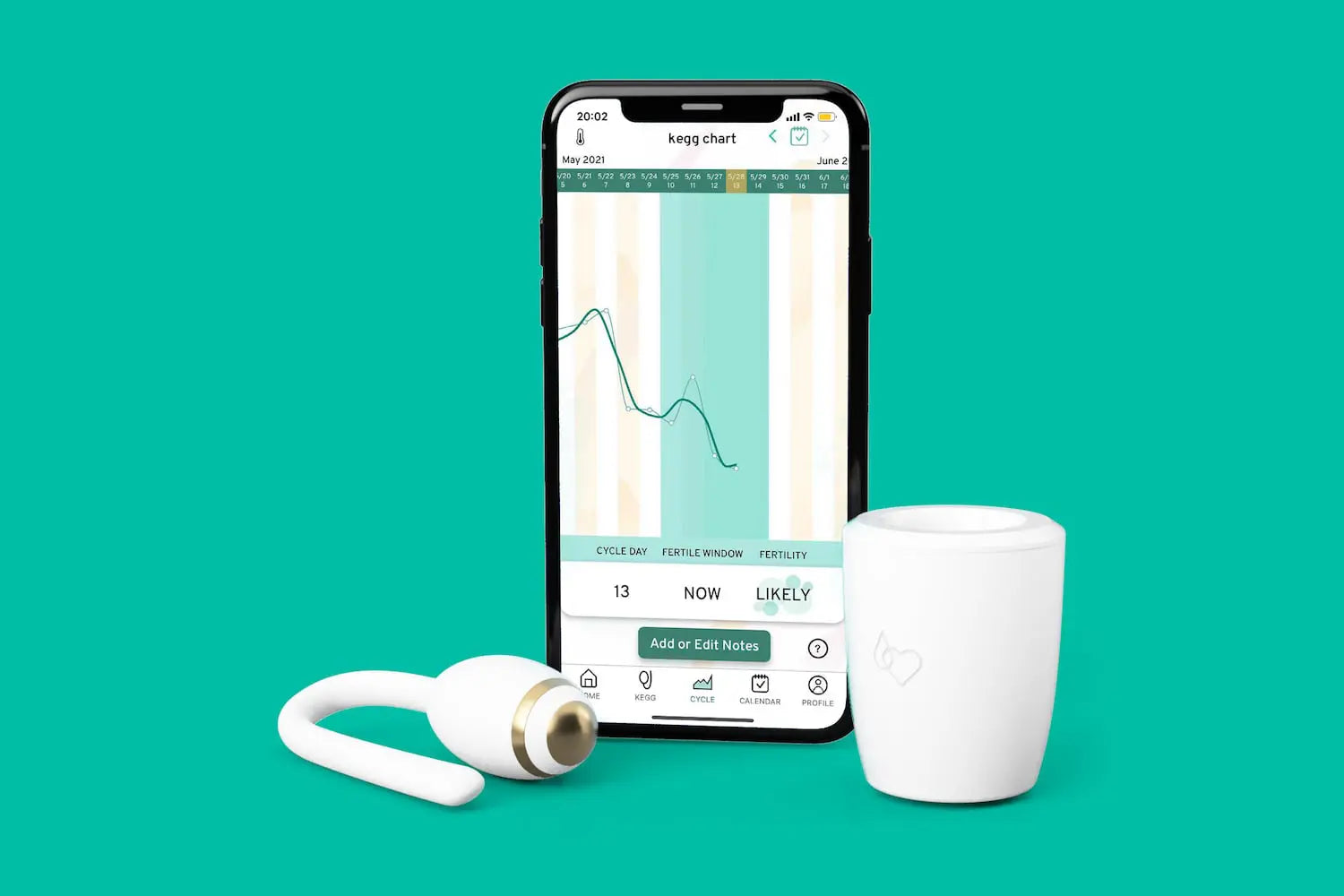At a Glance:
- Many FABM users complement their tracking method with kegg
- Sympto-Thermal Method (STM) users track cervical fluid observations as well as their basal body temperature (BBT).
- While learning to track your cycle using a fertility awareness based method can be time consuming and take several months to become proficient in, kegg takes the guesswork out of tracking the full fertile window.
- kegg users can conveniently input their observations into the kegg app to view all of their data in one location
- Tempdrop users can optionally sync their data to the kegg app to view both temps and kegg readings on their cycle view
Understanding your fertility can be a beautiful thing! kegg aims to help users gain valuable insights to their personal fertility patterns.
Women of all fertility goals have used the Sympto-Thermal Method (STM) for decades. Backed by science, STM has empowered women with the option to have a fuller understanding of their cycles and hormonal health. Sympto-Thermal Method users learn and chart daily biomarkers of cervical fluid and basal body temperature. There are extra biomarkers that can be included such as cervical changes, urinary testing of estrogen, LH (luteinizing Hormone) testing, and Progesterone with Proov, and now the one-of-a-kind kegg to detect the fertile changes in the vaginal environment!
Basal Body Temperature is the lowest body temperature attained during rest. Tracking basal body temperature includes taking a daily measurement of body temperature after a minimum of 4hrs of sleep, most often when first waking. A woman’s temperature responds to hormonal changes and, in a typical cycle, STM users will see lower temps before ovulation and then a sustained rise in temps after ovulation when progesterone becomes the dominant hormone.. Technology has advanced significantly in the past decades, from glass thermometers to digital thermometers, and now (wonderfully) to smart wearable thermometers that track your temperature while you sleep,like Tempdrop – my absolute favorite temperature tracking device since 2017, and NOW integrated it with the kegg app!
Cervical fluid is your first line of real-time information for current hormones at work. As estrogen rises when approaching ovulation, your cervical fluid changes to become more hospitable and nourishing to sperm, and follicles containing eggs begin to mature. STM users learn to distinguish peak and non-peak cervical fluid. All cervical fluid before ovulation is potentially fertile. Each Cervical fluid tracking method can have slightly different terminology for different types of cervical fluid. kegg can help in the learning process!
Women of all fertility goals have used the Sympto-Thermal Method (STM) for decades. Backed by science, STM has empowered women with the option to have a fuller understanding of their cycles and hormonal health. Sympto-Thermal Method users learn and chart daily biomarkers of cervical fluid and basal body temperature. There are extra biomarkers that can be included such as cervical changes, urinary testing of estrogen, LH (luteinizing Hormone) testing, and Progesterone with Proov, and now the one-of-a-kind kegg to detect the fertile changes in the vaginal environment!
Basal Body Temperature is the lowest body temperature attained during rest. Tracking basal body temperature includes taking a daily measurement of body temperature after a minimum of 4hrs of sleep, most often when first waking. A woman’s temperature responds to hormonal changes and, in a typical cycle, STM users will see lower temps before ovulation and then a sustained rise in temps after ovulation when progesterone becomes the dominant hormone.. Technology has advanced significantly in the past decades, from glass thermometers to digital thermometers, and now (wonderfully) to smart wearable thermometers that track your temperature while you sleep,like Tempdrop – my absolute favorite temperature tracking device since 2017, and NOW integrated it with the kegg app!
Cervical fluid is your first line of real-time information for current hormones at work. As estrogen rises when approaching ovulation, your cervical fluid changes to become more hospitable and nourishing to sperm, and follicles containing eggs begin to mature. STM users learn to distinguish peak and non-peak cervical fluid. All cervical fluid before ovulation is potentially fertile. Each Cervical fluid tracking method can have slightly different terminology for different types of cervical fluid. kegg can help in the learning process!
Through impedance technology, kegg is able to detect the changes in the cervical fluid which shift directly with the hormonal changes of the cycle, allowing users to more clearly pinpoint the fertile window.
STM treats cervical fluid and basal body temperatures as equals – partners for life! An STM user needs to chart both to have a full and accurate view of their current fertility. Using kegg with STM can offer more data (and who doesn’t LOVE more personalized information?)
Here are a few of my own charts to see for yourself. As you will observe, kegg can be an insightful fertility tracker to help users detect their full fertile window.
Here are a few of my own charts to see for yourself. As you will observe, kegg can be an insightful fertility tracker to help users detect their full fertile window.
- The thin green line is kegg’s data from my once daily readings, conveniently just two minutes a day.
- The bold green line is kegg’s trend line, displayed to help users see an overall pattern if readings should fluctuate significantly day-to-day.
- The thin black line are my temperatures recorded with Tempdrop
- The green columns represent kegg’s determination of the 5 day fertile window based solely on my daily kegg readings and personal cycle trends.
- Manual cervical fluid observations and temperature tracking are optional and do not have any bearing on kegg’s algorithm.

At the bottom of this chart, you will see my optional notes of positive LH tests on cycle days 12 and 13, and cervical fluid observations. I had peak-type cervical fluid on cycle days 10-13.

At the bottom of this chart you will see my optional notes of negative LH tests on cycle days 10 and 11, and cervical fluid observations. In this cycle of high stress I had only one day of peak type cervical fluid on day 10. And a very slow rise in my temperatures.

At the bottom of this chart you will see my optional notes of a positive LH test on cycle day 12, and cervical fluid observations. I had peak type cervical fluid on cycle days 10-12.
As a long time Symto-Thermal User, it’s so exciting to experience first-hand such incredible advancements in the fertility tracking world. The creators of kegg have put huge efforts into bringing their users useful data and a new view into their personal fertility patterns. kegg is proving to be an excellent tool for women seeking answers and data at their own fingertips!
NOTE: Many women use STM to both achieve or avoid conception naturally. kegg can support your STM charting with additional data but it is not recommended as a contraceptive tool.
As a long time Symto-Thermal User, it’s so exciting to experience first-hand such incredible advancements in the fertility tracking world. The creators of kegg have put huge efforts into bringing their users useful data and a new view into their personal fertility patterns. kegg is proving to be an excellent tool for women seeking answers and data at their own fingertips!
NOTE: Many women use STM to both achieve or avoid conception naturally. kegg can support your STM charting with additional data but it is not recommended as a contraceptive tool.

If you are a Tempdrop user, you can optionally view your temperatures in your kegg app, displayed with your kegg cycle data.
How to turn on Tempdrop integration To turn on Tempdrop integration in the kegg app, download the latest kegg app update
The kegg app will automatically pull up to 6 months of past temperatures from your Tempdrop account. Your Tempdrop temperatures will display in the cycleview of the kegg app. Tap the upper left thermometer icon to turn on and off the temperature display.
Tempdrop temperatures will display in light gray. Temperatures added by the user in the optional notes section will display in light tan.
Tempdrop temperatures will auto fill in all dates with tempdrop data. Dates without tempdrop data will be blank. Dates with temperatures added by the user will remain if no Tempdrop data is available for that date.
How to turn on Tempdrop integration To turn on Tempdrop integration in the kegg app, download the latest kegg app update
- In the kegg app, go to “PROFILE”
- Select “Apps & Services”
- Choose “Tempdrop LTD.”
- Select “Connect”
- You will be taken to Tempdrop’s login page and asked to approve the integration
The kegg app will automatically pull up to 6 months of past temperatures from your Tempdrop account. Your Tempdrop temperatures will display in the cycleview of the kegg app. Tap the upper left thermometer icon to turn on and off the temperature display.
Tempdrop temperatures will display in light gray. Temperatures added by the user in the optional notes section will display in light tan.
Tempdrop temperatures will auto fill in all dates with tempdrop data. Dates without tempdrop data will be blank. Dates with temperatures added by the user will remain if no Tempdrop data is available for that date.



